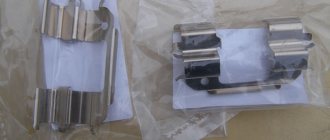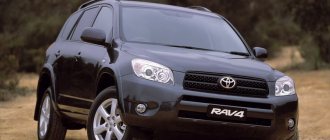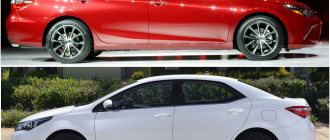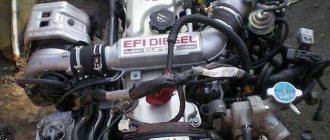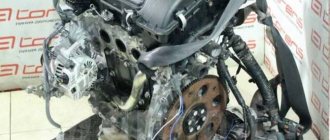4929 Apr 20
The Toyota Corolla 1.4 liter engine began to be installed on this model, starting with the restyled version of the eighth generation, which was produced from 1999 to 2002. It was a unit with an operating power of 97 hp. With. and a manual gearbox. It had good dynamics and fairly economical fuel consumption, ran on gasoline and accelerated to 100 km/h in 11.8 seconds. This engine was also present in subsequent releases; a Corolla could be purchased with this unit until 2008.
Description and technical parameters
The small-volume Toyota Corolla 1.4 liter engine is a 1.6 liter engine supplemented with a small crankshaft (piston stroke reduced to 71.3 mm). This is a four-cylinder injection unit with four valves each. Its working volume is 1398 cm3, and its power reaches 97 hp. With. And although the description shows that the engine cannot boast of being particularly dynamic and sporty, this is the kind of engine that will be relevant for those who want to get a reliable car at little expense.
Although the unit is inferior in power to other engines installed on Toyota, it is distinguished by economical fuel consumption in the range of 5.7–8.9 liters, depending on whether the car is driving around the city or on the highway.
This engine was offered only in combination with a five-speed manual transmission. It is the mechanics that ensure minimum fuel consumption, saving every liter of fuel in any operating mode. After 2008, it was changed to a modernized version of the small-volume 1.33 liter engine and was not used in new generations of Toyota. The latest engine was created on the basis of advanced engineering technologies and is in great demand among Corolla owners.
Even with a small volume and not the best dynamics indicators, the 1.4 liter engine installed on Toyotas of the eighth and ninth generations remains a reliable and stably operating unit that does not cease to operate even in extreme conditions.
VKG system
If the CPG is seriously worn out, this is fraught with high pressure created by crankcase gases. On the 1.4 D-4D, the first thing you need to check is whether the unscrewed oil filler plug jumps up when the engine is running. A symptom of a VCG malfunction is also an oily tube connecting the valve cover to the inlet pipe.
The turbine suffers from high pressure of crankcase gases and wears out quickly, oil appears in the intake or exhaust tract and can squeeze out the seals.
Reviews
Sergey, driving experience - 3 years
I got the Corolla from my dad, as a poor student. What was gone is gone. But I'm not complaining. Although the engine cannot boast of sportiness. It’s especially noticeable on the highway; if you want to overtake, you need to downshift to get the required speed.
Ivan, driving experience – 7 years
When the choice arose about which car to buy, I decided to read the reviews first and chose the 2003 Toyota Corolla 1.4 liter. Why? Yes, because I didn’t intend to participate in super races, but wanted to buy something economical and not go beyond the budget (550,000 rubles). I drive it only on weekends, on weekdays I work, and it’s two steps to work. So far the engine has not had any malfunctions, everything is ok, it has only undergone one maintenance, everything is fine, and it was inexpensive. I'm happy with the car.
Sergey, driving experience – 25 years
I have a 2008 Corolla with a 1.4 liter engine. And although the characteristics of this unit are not replete with a large number of positive reviews, it is optimal for those who love a calm and confident ride. And in combination with low fuel consumption, this is what a driver like me needs (we mostly go to the country on weekends).
Kirill, driving experience – 17 years
I was choosing between a Honda Civic and a Corolla, but in the end my wife decided on the latter option. Now I'm glad I agreed. The dynamics are excellent, the consumption is low, and it doesn’t break through on potholes and ruts. Even in severe frosts (-40°C) it started perfectly without problems.
Toyota Corolla'2008 (sedan, 1.4 l, manual)
I'll start with how I purchased the car.
I decided to buy a car in 2008. Due to limited funds, I wanted to take it with mileage. I immediately leaned towards the TOYOTA brand. Since I wanted to take out a loan, banks charged large amounts for CASCO and interest on the loan for a used one. I decided to go to the dealer. I immediately fell in love with the Corolla. When calculating the acquisition costs, the amount suited me; it turned out to be a little more expensive (taking into account insurance and the amount of payment for the loan) than I would have bought a used 2006, but with an automatic transmission. Of course, I chose the basic package, but it has everything you need: CD with MP3, air conditioning, heated front seats, headlight washers, etc. Before that I looked at the KIA Sid, to get the same equipment for a KIA, I would have to pay about 80,000 more rubles.
So, Corolla 2008, 1.4, gray, Japan, in the base with the installation of an alarm system with a / g cost me 520,000 rubles. Mats, engine protection. bought it at the market. Officials have 0 maintenance, i.e. with a mileage of 1000 km, I installed protection, carried out diagnostics, and stretched all components and assemblies. I didn’t go to the officials again.
Today the mileage is 86,000 rubles. I'm just happy. Judge for yourself, change oil and filters every 10,000 km. Non-original oil filter - 270 rubles, air filter - 400 rubles, cabin charcoal filter - 450 rubles, everything was changed as required according to technical requirements. service, in a proven service (I live far from the official one))). Amounts without work.
Only at 50,000 km I changed the bushings of the front stabilizer struts, 2 pieces, about 300 rubles. At 60,000 km. I changed the front and rear brake pads (RUB 1,500), although after replacing I saw that the rear ones would have worn out just as much))). Amounts without work.
I used the car in an average manner. I have been to long distances, with good and bad roads. Never let me down. Started at - 32 C without problems. The battery is good, it's in its 5th year, I only charged it this winter of 2013 because I felt that the engine was starting to turn poorly.
The suspension is soft, the ground clearance is high, it rarely gets stuck anywhere. I caught it only when I went into nature, along some gullies. It is stable on the highway, the dynamics may be a little better than those of the VAZ-2114 (but it only ran up around 30-40,000 km). Sometimes he flew into holes. But to break through the suspension, you have to try really hard. Consumption surprised me - 5.9 liters, at an average speed of 100 km, but mostly 120-140 km/h. along the highway (I drove from Perm to the Kurgan region - 1000 km). I have never shown such consumption again. On average 6.5-7 liters.
Interior: heated seats are excellent, music is good, sound insulation is good, spacious interior. One day we had to bring blinds 3 meters long. I opened the trunk, folded down the back seat, the front seat, opened the glove compartment, put some of these blinds in the glove compartment and slammed the trunk. CHECK - it's true! One drawback is that the front glass fogs up in winter, so you have to increase the airflow on the glass. But it doesn't bother me much.
I’m thinking about changing my car because I want an automatic and with climate control, again I’m looking at a Corolla or a Camry.
The overall impression is a very decent car. Compared to other brands of the same class that my family and friends own and the problems with their new cars, my Corolla is a GREAT CAR!!!
Previously owned the following cars: VAZ-2106, VAZ-2107, VAZ-21144, drove (for a long time) - Kalina, Chevrolet Lacheti, Chevrolet Cruze, Mitsubishi Outlander.
injection pump
The injection pump model CP3S3 from Bosch, which has received mechanical pumping, has a huge service life and is relatively durable. Difficulties with it are quite rare. But there is a risk of breaking this pump if you use low-quality and contaminated diesel fuel, which acts as an abrasive on the surface of the pumping section. At the same time, the plungers may also fail.
With significant mileage and operation at sharply negative temperatures, fuel may leak through the pump caps. To fix the problem, it is enough to replace the sealing gaskets by purchasing a repair kit.
Also, another infrequent problem can be a diesel leak in the place where the internal pump shaft seal is installed. This risks mixing diesel fuel with engine oil due to its entry into the cylinder head space.
To buy injection pumps or injectors, use our auto parts catalog.
Fuel getting into the oil
The first versions of the engine, which did not have a particulate filter installed, often “delighted” car owners with an increased oil level in the sump. This usually happened because of the injectors, the nozzles of which were pouring fuel heavily. But the cause could also be a malfunction of the engine ECU, due to which the injectors (one or several at once) were constantly pouring diesel fuel. There is a version that not only completely replacing the ECU, but also resoldering its transistors helped eliminate the problem.
Errors in the operation of the unit can be identified by the positive on-board power supply remaining on the injectors when the engine is turned off.
Turbocharger
The first versions of the internal combustion engine were equipped with Toyota turbines: CT2 or CT9 with a built-in bypass valve. Their design is made in the form of a hot part combined with the exhaust manifold.
In 2005, the internal combustion engine was modified to produce 90 liters. With. received a Garret GT1444V turbocharger. It has a geometry variable with a rod and operates under the control of a vacuum actuator.
Towards the end of 2008, the manufacturer began installing new Garret GT124 series turbochargers, which also received variable geometry, for which an electric servo drive manufactured by Denso was responsible.
Difficulties with the turbocharger usually do not arise, and if they do, the reason must be sought in the internal combustion engine itself. In particular, the already mentioned crankcase gases, due to high pressure, do not allow the oil to drain from the turbine, and then it begins to press through the seal rings located on the shaft. As a result, the oil ends up in the intake or exhaust tract, but the reason here is not in the turbine, but in the internal combustion engine itself.
The original version of turbocharger 1 D-4D operates autonomously: the bypass valve installed in the hot part of the volute is activated due to the build-up of excess pressure in the cold part. Then it is transmitted through the tube to the bypass valve actuator.
You can select a turbine for a Toyota diesel engine using our auto parts catalog.
EGR valve
There are no difficulties with the EGR valve on this engine. But when the engine loses traction and dynamics, or if you move at a constant speed and speed, it seems to slow down, then this may indicate a stuck valve. As a result of jamming, more exhaust gases enter the intake tract than necessary. You can usually get rid of the problem by cleaning the EGR valve.
You can select an EGR valve for Toyota 1.4 D-4D in the company’s auto parts catalog.
Fuel pressure regulator valve
This valve is the most frequently broken element. If it malfunctions, errors occur related to low or high diesel fuel pressure in the rail, or a malfunction of the control valve. Typical symptoms are difficulty starting, the ability to spin the internal combustion engine over 3000 rpm, and stopping it under load, which is fraught with danger when driving on the highway.
Cleaning the valve does not always help - it is better to replace it with a new one. The reason for its malfunction is a clogged mesh due to both impurities in diesel fuel and lint from a low-quality fuel filter.
If by cleaning it was not possible to achieve its normal operation, then the reason is severe wear of the needle, as a result of which the valve randomly releases diesel fuel, creating a lack of diesel fuel pressure in the rail.
You can find the fuel rail in the auto parts catalog.
Pistons
CPG pistons use non-resistive cast iron - due to inserts made from it, their strength and heat resistance are increased. These inserts, in turn, have grooves into which the piston rings fit.
To select auto parts and attachments for the 1.4 D-4D diesel engine, use our catalog of contract auto parts.
Using these links, you can check whether certain Toyota car models are available at the dismantling shop and place an order for spare parts for them.


